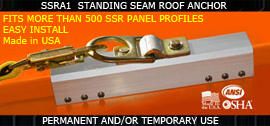| Buyer's Guide |
 |
| Product FAQ's |
| |
A: The ANSI Z359 Fall Protection Code
allows for a 6-foot maximum free fall distance. OSHA allows the free
fall distance to exceed 6 feet as long as the arresting forces are below
1,800 lbs. for a full body harness system and as long as there is
sufficient clearance.
A: The maximum elongation of a lanyard
meeting ANSI requirements (6 ft. free fall models) is 48 inches. OSHA
standards and the OSHA test procedures allow up to 42 inches. You must
judge the clearance in a given situation when determining what length to
use. Capital Safety provides clearance charts with our products to help
select the proper product for your application.
A: The term “100 percent fall
protection” means that, at all times when a person is exposed to fall
hazards (when at or above a given height), he or she must be protected
by an active or passive fall protection system. Active systems include
fall arrest systems such as a full body harness, lanyard and anchor
point. A passive system could be a guardrail or net.
For
example, if a company indicates that 100 percent fall protection is
required above 6 feet, a worker climbing a fixed 20-foot ladder to a
roof should be protected by a cage, ladder safety system or other active
fall protection while climbing as well as when exiting the ladder onto
the roof. A positioning or travel restraint device could be a part of
this 100 percent fall protection system. However, most often a backup
fall arrest rated system is also used while connected to the positioning
or travel restraint system.
A: Yes, if the scaffold will support the
potential loadings, and the scaffold manufacture approves such use, you
can attach your fall protection system. Make certain your connecting
hardware incorporates hooks large enough to fully close and lock when
attached to the scaffolding (ex. Lanyard with rebar hook).
A: A harness should be worn over winter
clothing. It is more visible for inspections and there is less chance
for clothing to interfere with buckles and snaphooks. Additionally, when
the harness is on the outside, if there is a fall and the harness is
pulled upward, there is less possibility that the person could be
choked.
A: Within ANSI Z359-2007, there is no
specific height. ANSI only states that workers should provide a safe
workplace for employees exposed to fall hazards. Within the OSHA fall
protection standards, there are trigger heights for various work
activities. In some cases, 4 feet is used as a common trigger height in
General Industry. In the Construction industry, it is 6 feet for most
activities. What fall protection applications do my harness D-rings comply with?
- Fall Arrest (6 foot free fall): Dorsal (back)
- Restraint: Dorsal (back), Chest, Side, Shoulder
- Work Positioning: Side, Shoulder
- Rescue/Confined Space Entry: Dorsal (back), Chest, Shoulder
- Climbing: Dorsal (back), Chest
When working on a leading edge, do I have to have a shock absorber with my retractable or can I just use my heavy duty lanyard?
You must use a Heavy Duty Lanyard or Self-Retracting Lifeline when working on a leading edge. What is the maximum lanyard length allowed in Climbing/Fixed Ladder applications?
The maximum total length allowed between the fall
arrester (rope grab) and the full-body harness attachment point (Dorsal
(back) or Chest D-ring) is 36 inches. Refer to ANSI Z359.1-2007, 3.3.6. |
| How do I buy/redeem a gift certificate? |
| |
To purchase a gift certificate for someone, click here. If you are the recipient of a gift certificate and would like to redeem your gift certificate, click here. |
| How do I find my product? |
| |
To find the product(s) you're looking for, you may (1) use the navigation menus on the top, left & bottom of our website. (2) type a keyword into the SEARCH box. If you have any trouble locating a product, feel free to contact customer service for assistance. |
| How do I navigate the site? |
| |
To navigate this website, simply click on a category you might be interested in. Categories are located on the top, left & bottom of our website. QUICK TIP: Place your mouse cursor over anything you think could be a clickable link. You'll notice that anytime you scroll over something that is a link, your mouse cursor will become a "hand". Whereas scrolling over anything that is NOT a link will leave your cursor as an "arrow". You may also type a keyword into the SEARCH box to quickly find a specific product. If you have any trouble locating a product, feel free to contact customer service for assistance. |
| How do I use a coupon? |
| |
After adding items to your cart, click the "View Cart" link at the top of this site to view your cart. At the bottom of the shopping cart you'll see a box where you may enter your coupon code. |







